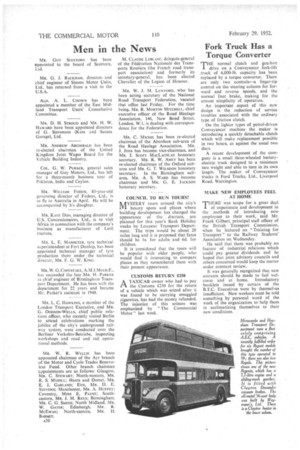Fork Truck Has a Torque Converter
Page 32

If you've noticed an error in this article please click here to report it so we can fix it.
THE normal clutch and gearbox drive on a Conveyancer fork-lift truck of 6,000-lb. capacity has been replaced by a torque converter. There are only two controls—a finger-tip control on the steering column for forward and reverse speeds, and the normal foot brake, making for the utmost simplicity of operation.
An important aspect of this new design is the reduction of service troubles associated with the ordinary type of friction clutch, On the lighter types of petrol-driven Conveyancer machine the maker is introducing a quickly detachable clutch which will make replacement possible in two hours, as against the usual two days.
A recent development of the company is a small three-wheeled batteryelectric truck designed to a minimum tare weight and able to turn in its own length. The maker of Conveyancer trucks is Ford Trucks, Ltd., Liverpool Road, Warrington.
MAKE NEW EMPLOYEES FEEL AT HOME THERE was scope for a great deal 1 of experiment and development in the methods of introducing new employees to their work, said Mr; Frank Gilbert, principal staff officer of the British Transport Commission, when he lectured on "Trainingfor Transport" to the Railway Students' Association on Wednesday.
. He said that there was probably no feature of industrial relations which could pay greater dividends and he hoped that joint advisory councils and others concerned would keep the matter under constant review.
It was generally recognized that new entrants should be made to feel welcome and at home. Introductory booklets issued by certain of the B.T.C. Executives were by themselves insufficient. New workers must be told something by personal word of the work of the organization to• help them in acclimatizing themselves to their new conditions.




















































































